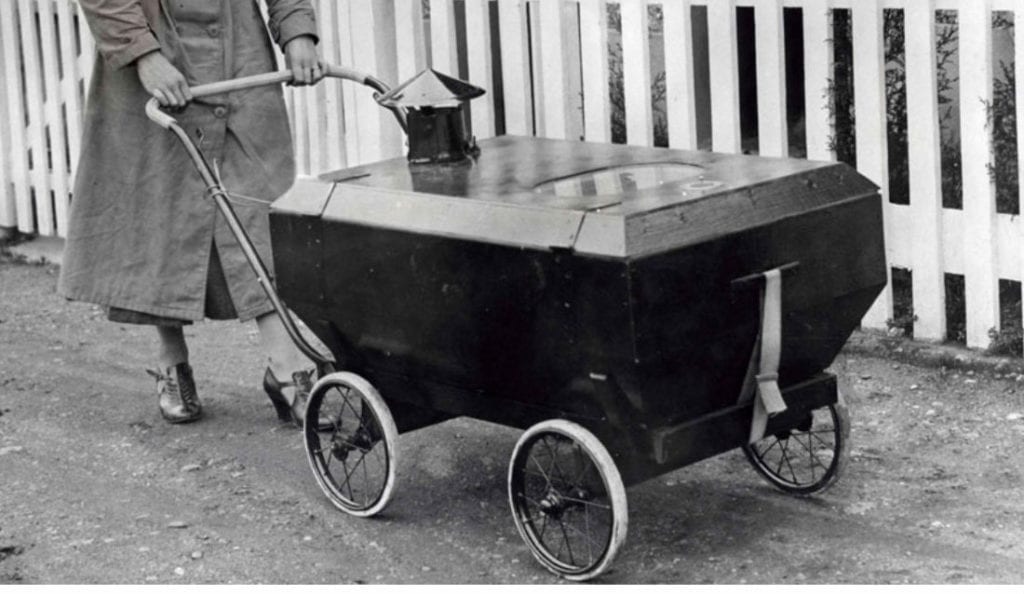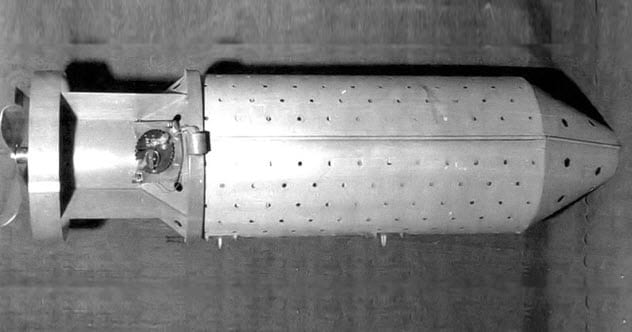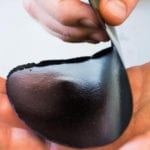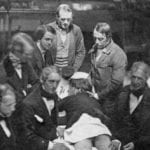 Mysteries
Mysteries  Mysteries
Mysteries  History
History 10 Surprising Stories About the Texas Rangers
 Humans
Humans 10 Philosophers Who Were Driven Mad by Their Own Theories
 Miscellaneous
Miscellaneous 10 Video-Game-Worthy Weapons and Armors from History
 Weird Stuff
Weird Stuff 10 Psychics Who Accurately Predicted Wartime Events
 The Arts
The Arts 10 Pieces of Art Inspired by a Broken Heart
 Health
Health 10 Science Fiction-Sounding New Medical Treatments
 History
History 10 Surprising Facts About the Father of Submarine Warfare
 Space
Space Ten Astonishing New Insights into Alien Worlds
 Weird Stuff
Weird Stuff 10 Bizarre Summer Solstice Rituals Still Practiced Today
 Mysteries
Mysteries Top 10 Haunting Facts About the Ghost Ship MV Alta
 History
History 10 Surprising Stories About the Texas Rangers
 Humans
Humans 10 Philosophers Who Were Driven Mad by Their Own Theories
Who's Behind Listverse?

Jamie Frater
Head Editor
Jamie founded Listverse due to an insatiable desire to share fascinating, obscure, and bizarre facts. He has been a guest speaker on numerous national radio and television stations and is a five time published author.
More About Us Miscellaneous
Miscellaneous 10 Video-Game-Worthy Weapons and Armors from History
 Weird Stuff
Weird Stuff 10 Psychics Who Accurately Predicted Wartime Events
 The Arts
The Arts 10 Pieces of Art Inspired by a Broken Heart
 Health
Health 10 Science Fiction-Sounding New Medical Treatments
 History
History 10 Surprising Facts About the Father of Submarine Warfare
 Space
Space Ten Astonishing New Insights into Alien Worlds
 Weird Stuff
Weird Stuff 10 Bizarre Summer Solstice Rituals Still Practiced Today
Top 10 Most Gruesome Inventions And Innovations
Since the dawn of mankind he has been striving to make life easier through invention and innovation. Many of his creations have been lifesaving and have saved us all time by making us a much more productive civilization, while others have been purely evil and have reflected man and his inhumanity to his fellow man. Throughout time there have no doubt been many more inventions that have failed miserably and thus have never seen the light of day, while at the same time a good number should never have made it past the drawing board. Plastic is one of these that always creeps into this writer’s mind. This invention has been so useful it is hard to imagine life without it, but yet there’s a giant mass of this substance in the Pacific Ocean dubbed the “Great Pacific Garbage Patch” which glaringly illustrates the harsh, long-term effects of this most useful invention. Please keep reading to learn more on just how insensitive, and sometimes downright creepy, yet brilliant, man’s inventive mind has been, and can be…
10 Homegrown North Korean ‘Inventions’
10 Gas Resistant Strollers

In England, a quite ungainly contraption known as the “Gas-Proof Pram,” was born out of fear and necessity. These gas-proof prams, or gas-resistant strollers were a product produced in the late 1930’s, both by the use of mustard and chlorine gas in World War One and the looming threat of their use again by the new Nazi regime. Although there is not much information available on these short-lived things (hence the reason for the brevity of this article), they were produced by F.W. Mills hailing from Kent in South East England to protect babies and toddlers from deadly gas in the advent of German air raids. These strollers were generally equipped with a lid that had a glass panel and a gas filter on top. On the rear the stroller was also fitted with a motor horn bulb to ventilate stale air from the interior. Fortunately, these disturbing devices were never needed for their intended purposes and were never produced in any great quantities, and were never tested in battle.
9 The Cotton Gin
Invented by Eli Whitney in 1793 and patented by him the following year, the cotton gin revolutionized the industry in America by allowing far more of the so-called “white gold” to be processed. The cotton fibers were made into goods like linens, and what was left undamaged was used mainly for textiles such as clothing. This radical growth in the cotton industry unintentionally caused an exponential growth of slavery in the American south with a sharp increase in the demand for cotton laborers. The machine itself did indeed radically reduce the labor involved with processing the plant; the immediate effect was a sharp increase for more of it to increase profits to meet the increasing demand for it, along with the land needed to grow it, but it did not assist with the harvest, so more and more slaves were needed for this latter part of the operation. For example; there were six slave states in the year 1790. By 1860 that figure had more than doubled to 15. From 1790 to 1808, the year Congress banned the importation of African slaves; southern slave states had imported over 80,000 slaves and by 1860 about one out of every three Southerners were African. As a direct result of the invention of the cotton gin, it is regarded as the most important, albeit inadvertent, event leading up to the start of the American Civil War, which lasted four years, from 1861 through 1865, and cost at least a half a million American lives (with new estimates reaching three quarters of a million), along with at least a million non-lethal casualties.
This makes it by far the bloodiest conflict in the history of the United States—and it all started with the invention of a simple machine.
8 Bat Bombs

Pennsylvania dentist Lytle S. Adams was on vacation at the famous Carlsbad Caverns when the Japanese attacked Pearl Harbor on 7 December, 1941. The caverns being the home of around a million bats Doctor Adams was very impressed with the animals. So, after hearing about the viscous attack on the radio, he was quick to come up with a very devious and quite unique plan of vengeance against the Japanese Empire—The Bat Bomb. In less than a month, on 12 January, 1942 he sent word of his plan to Washington—Incinerate Japanese cities by attaching minute incendiary bombs to tens of thousands of bats and let them loose over the skies of Japan (which were constructed primarily of wood and thatch by the way)! The doctor later recalled excitedly, “Think of thousands of fires breaking out simultaneously over a circle of forty miles in diameter for every bomb dropped! Japan could have been devastated, yet with small loss of life.”
It just so happened that Doctor Adams knew Eleanor Roosevelt so his plan managed to get a high-level audience with the military brass there. The National Research Defense Committee decided to accept his proposal and after some research decided to use the Mexican free-tailed bat and Doctor Adams et al. went to Washington with an unarmed dummy bomb to demonstrate the concept. The extremely complex design became known as “Project X-Ray” and the myriad of problems with the design would soon become evident when a hanger and an Army general’s car were set ablaze and burned. After this the Marines took the project over and soaked two million dollars into it. Soon afterwards, the project was dropped due to advancements with the Manhattan Project and the expected success of the atom bomb. This was quite fortunate for many Mexican free-tailed bats and Japanese civilians alike.
7 Urban Baby Window Cages
Imagine Mom, it’s 1922. It’s a scorching hot and horribly humid summer day in your tiny 30th floor apartment somewhere in Anytown U.S.A. (only 300 feet above the street below). Supper is in the oven so you can’t leave, and the elevators of the day are dangerous at best. It’s just you, your 3-year old son, and your 8-month old daughter who is miserably hot and Dad’s at work. So what to do with Susie? Suddenly you think, ‘I know! I’ll stick her out the window!’( I don’t think so!) Well, that is exactly what some parents used to do before the advent of air conditioning! In the late 19th century a one Doctor Luther Emett wrote a parenting book called, “Mental Floss” that suggested parents should “air out their kids” to “renew and purify their blood.” So what happened? Some brainiac came up with the idea of “airing out kids” in baby cages bolted to the outside of skyscrapers—and some people, parents, actually bought them! I mean what could possibly go wrong? Do I even need to state the obvious myriad of horrific possibilities from bird droppings to hail storms to loosening bolts? Needless to say these horrible contraptions, which were not much more than human chicken coops, neither caught on, nor “hung around”—the pun being totally intended.
6 Hydrogen Blimps
It is bad enough that inventors have always felt the need to burn things just to get them to work, but hydrogen blimps were ridiculous indeed, and are considered as one, if not the most dangerous inventions of all time. Take the rest of our mass transportation systems for example. Everything on land, sea, air, rail, and space uses volatile fuel of some kind, including electric vehicles, but at least they have fuel tanks and fuel cells that are well-protected from damage and thus the engineers have taken the danger of the fuel these vehicles use into account. Yet hydrogen blimps are nothing but glorified balloons with a frame, and to load passengers on them and take to the sky is ludicrous. Yet airships such as the Hindenburg illustrated this in the most horrific manner possible, even though dozens went down in the years before her. They crashed during fueling, they crashed during takeoff, they crashed in flight, they crashed while docking, and were lost in battle, so they literally failed in every aspect of their use. Nazi Germany had an excuse for using hydrogen since the United States wouldn’t sell her helium, which was very expensive so they couldn’t afford it, but what did that say about the “glory” of the fatherland? After 29 years of continuous loss of life and limb one would think that these airlines would have quickly make the switch to the much safer, yet more expensive helium, but as history shows, mankind is a stubborn lot indeed. Obviously blimps, or dirigibles, are still used today but not for mass transit, and all are required by law to use helium for lift.
Simply put, hydrogen-filled airships were an extremely dangerous form of transportation. For example; from 5 August, 1908 through 6 May, 1937 (the fateful day of the Hindenburg disaster) twenty-two airships crashed to the ground and burned. That is an average of 0.75 airships crashing per year for twenty-nine years, and the source list this information was derived from was only a partial list that did not include those airships lost in battles. So it is safe to say that more than one hydrogen airship was crashing to the ground and burning per year during this timeframe. If passenger planes were ever dropping from our skies at this alarming rate the industry simply would not exist today.
What were they thinking?
5 The Shoe-Fitting Fluoroscope
In Boston, Massachusetts, Doctor Jacob Lowe demonstrated a shoe-fitting fluoroscope in 1920 at a shoe retailer convention. He did so again in 1921 in Milwaukee, Wisconsin. He filed for a patent for it in 1919 and had it approved in 1927. The shoe-fitting fluoroscope utilizes X-rays to create moving images of the interior of an object in real-time so it is easy to imagine how fascinating it would be to children who would have such inexpensive and easy access to such technology—which would be fine if it wasn’t deadly. The selling point for this technology was nervous parents worrying about the damage caused by their kids wearing ill-fitting shoes. The problem was, not only was these machines ineffective at fitting shoes, but during a 20-second viewing the American-made machines delivered about 13 roentgens (0.13 sievert (Sv), and although British Pedoscopes were around 10 times less powerful they were still dangerous. Even though the radiation was directed towards the feet, much of it would scatter, radiating everyone around the machine. Sales persons are believed to receive up to a years’ worth of radiation exposure in just 2 hours! In addition to the little girl mentioned above there have been reports of other injuries such as dermatitis with ulcerations, burns requiring amputation, and basal cell carcinoma, with many more likely as late as 2004, and an untold number associated with these devices. These infernal machines were finally banned in 1970. For many, it was too little, too late.
4 The Brazen Bull

There was a beautiful bronze statue cast in ancient Greece that is said to have beheld a horrific and dark truth—a foreboding and murderous truth—it was the final truth that death always brings. It was the Brazen Bull invented by Perillos of Athens between 570 and 554 BC. The statue was commissioned during the reign of Phalaris, the evil tyrant of Acragas, in Sicily, who was notorious for such atrocities as eating newborn babies, as an exceptionally cruel torture device. The bull was cast hollow, and used with a fire built below. It was designed so it could be opened and a person placed inside, a fire started underneath, and as the person started to burn the smoke and steam would escape through the bull’s nose. Incense was placed inside to counteract the smell of burnt flesh. It is said that there was a series of tubes built into the statue designed to distort the screams of the victim making them sound like the animal it depicted. After the victim had burned away, the bones would be collected for bracelets that Phalaris would wear. When Phalaris wanted to test the sound system, he pushed Perillos into the very device he created and lit a fire, but released him before he died, only to kill him by heaving him down a steep incline. Ironically, Phalaris died by his own commissioned torture device when his reign ended after the city was taken by Telemachus in 554 BC and he was cooked in his own Brazen Bull. Talk about Karma.
3 The Tricho System
Marketed as an award-winning innovation, the “award” the Tricho System won was a “grand prize” and was sold by a man named Max Kaiser, a Londoner, who began selling the machines in 1914 to anyone with four-hundred dollars to spend. Making arrangements at one of the “International Exhibitions” of the time Kaiser more or less “guaranteed” the exhibit would win either a “gold medal” or a “grand prize.” In fact, quite dubiously, the manufacturer didn’t have to pay a fee to Kaiser until after this medal or prize was first awarded. The Tricho System won its prize on 19 October, 1925, at the Paris Exposition Generale Commercial. By the end of 1925 over 75 Tricho Systems were installed in beauty salons across the United States including Duluth and Minneapolis. These devices utilized direct X-ray beams to focus on the woman’s cheeks and upper lips to permanently remove unwanted hair. Most women would go through an average of twenty treatments apiece. Either small doses repeated over longer periods of time, or a single large dose could cause serious damage to facial tissue that wasn’t noticed at first, but would come back to haunt them as ailments such as keratoses, pigmentation, ulcerations, wrinkling atrophy, carcinoma, and even death started to occur. Over time the AMA collected dozens of case studies and alerted its members to the issue, and reports of injuries to women treated by Tricho System treatments appeared in medical literature well into the 1940’s.
Here is yet another case of man’s ignorance to the dangers of radiation. But again, along with other toxic substances such as radiation, hydrogen, and lead, it never ceases to amaze this writer how long things such as this persist before they are taken off the market. Take lead for instance—there are scholars who think the use of lead plumbing and pewter utensils in the Roman Empire may have facilitated their demise, yet the United States didn’t ban the use of lead-based paint, or leaded gasoline until 1978, and the fluoroscope mentioned above wasn’t banned until 1970. A more modern example is Teflon, which was banned from domestic production in 2014, yet it still can be imported as of this writing. When will we ever learn?
2 Agent Orange
Originally developed to simply enhance the growth of soy beans, Agent Orange (consisting of about equal amounts of dichlorophenoxyacetic acid, trichlorophenoxyacetic acid, with small, variable proportions of tetrachlorodibenzo-p-dioxin) was weaponized and used extensively during the Vietnam War. Used in large quantities it was a powerful herbicide used by the United States to deforest the jungle and destroy Viet Cong and North Vietnamese Army crops. Under the codename Operation Ranch Hand, the United States military sprayed upwards of twenty millions gallons of herbicides over Laos, Vietnam, and Cambodia from 1961 through 1971, covering over 4.5 million acres. Containing the carcinogen dioxin, Agent Orange was the most used of these herbicides (13 of the 20 million total). Agent Orange was proven afterwards to cause very serious health problems for both the Vietnamese people and returning United States military personnel and their families. Among these were rashes, birth defects, severe neurological problems, psychological problems, and cancer. Notwithstanding are the immense environmental damage this military action has caused to the nation of Vietnam since that country has since reported that 400,000 of their people were maimed or killed by the abuse of these herbicides, and that 500,000 of their children have been born with birth defects caused by being exposed to Agent Orange. They also claim that as many as 2,000,000 of their citizenry have contracted cancer or some other form of illness due to the use of these dangerous chemicals in their country.
1 The Radium Girls
“Look Honey! A watch that glows in the dark!” This excited comment was undoubtedly repeated many times over and over a century ago, when excited shoppers first laid their eyes on watches and clocks with hands and dials that “magically” glowed brightly in the dark of night. But little did they know that this was a deadly and highly toxic “magic,” with horrifying consequences for the women making the magic happen. In 1916 the first plant to make these “magical” devices magic opened up in New Jersey and hired around 70 women. They would be the first in a wave of thousands to gain employment in similar plants across the United States in a good-paying, seemingly glamorous vocation.
The task of applying the very special glow-in-the-dark paint to the minute dials faces was both painstaking and very delicate, requiring a good eye, and plenty of manual dexterity, so the girls were instructed to wet their brushes with their lips to give them a good, sharp point. Therein was their downfall. The paint glowed so efficiently because it contained a not fully understood new element discovered only 20 years before called radium, and radium is highly radioactive. As it turned out the girls were swallowing it on a daily basis. In spite of this radium quickly turned into the craze of the day, ending up in everything from cosmetics and toothpaste to soft drinks and food items. The problem is, when one ingests radium the body mistakes it for calcium and incorporates it directly into bone tissue quickly causing radiation-induced bone necrosis and bone cancers.
One of the saddest aspects of this story is that the so-called “Radium Girls” didn’t rush into this blindly. They asked their employers whether or not the paint was harmful or not and were ensured that it wasn’t. In short, they were lied to, whether intentionally or by ignorance, it doesn’t really matter. What does matter is what happened to many of these poor girls. The most insidious part of this is that it took years for the symptoms to show up making it hard to prove the cause of their problems, especially since radium gives the illusion of good health when ingested by stimulating red blood cells, when in reality you’re being slowly poisoned. At the time, radium was the most expensive substance on the planet costing a whopping 2.2 million dollars per gram in today’s money! Adding to the mystique of the job the Radium Girls were listed in their local phone directories as “artists” prompting them to get friends and family to seek employment with them.
Another sinister aspect to this whole thing, was that the radioactive dust created in the plant shimmered so brightly, that the girls would wear their finest dresses to work so they could be seen afterwards at their favorite speakeasies being the shiniest ones on the dance floor. Early in the 1920’s though, some of the Radium Girls began suffering from symptoms such as severe toothaches and fatigue, with the first known death happening in 1922 when Mollie Maggia died at only 22 after a year of pain. Even though her death certificate wrongly stated that she died of syphilis she was really suffering from what was called “radium jaw,” a condition that caused her entire lower jawbone ending up being so soft and brittle that her doctor simply lifted it off of her face! The radium was doing nothing less than drilling holes in her jawbone while she was still alive!
Fortunately, the Radium Girls did not suffer in vain. Their cause eventually changed labor laws for the better in the United States for all factory workers. As they should have.
10 Bizarre Inventions From The Victorian Era








